Dealing with fungus gnats in household plants can be a common nuisance, but I’m going to share some simple steps you can take to naturally eliminate fungus gnats—FOR GOOD! From adjusting watering habits to using natural remedies, getting rid of these pesky insects simply takes a bit of diligence and time.
The key to getting rid of fungus gnats is to eliminate the larvae. But it can be tricky to do this naturally. Since the adults only live for a few days, once all the larvae is dead, the infestation will go away pretty quickly.
This is easier said than done though. The adults can fly, jump, or crawl from one plant to the next, so it can be difficult to eradicate them.
So you have to be persistent in treating them, and ensure that you are diligent about keeping your houseplants healthy to prevent recurring outbreaks.
A Bit About Fungus Gnats
Fungus gnats are tiny black bugs that crawl on top of the soil and fly around your houseplants. They are the most common houseplant pest there is, and they can quickly infest your entire collection. Yuck!
Though the look very similar to fruit flies, they are not the same type of bug. You can read all about how to tell the difference between the two here, so you can make a positive ID.
Fungus Can Multiply Quickly!
There are 4 stages to the fungus gnat life cycle. In the right environment, they can multiply very quickly, and their full lifespan can happen in less than a month.
The adults only live for a week or so, but the females can lay hundreds of eggs during their life. So if you don’t take the right steps to eliminate them, their population can explode in a short amount of time.

9 Natural Fungus Gnat Treatments
There’s no need to resort to chemical pesticides, you can easily fight these pests using natural and organic treatment methods. For the quickest results, you should try all of these:
1. Proper Watering
The #1 reason fungus gnats get into your plants is from overwatering. The larvae thrive in wet soil, and they can’t survive when it’s dry.
So, the easiest and most effective method of eliminating them is to make sure you always water your houseplants correctly. The soil should feel dry to the touch, and never be saturated or soggy.
If you struggle with this, I highly recommend getting an inexpensive moisture gauge to make sure you get it right every time.
2. Water From The Bottom
Fungus gnat larvae live in the top 1 inch of the soil, which tends to stay pretty moist when you water plants from the top. So if you have persistent problems, then try watering from the bottom instead.
To do that, simply pour water into the drip tray or cache pot, and allow the plant to soak it up through the drainage holes in the bottom of the container.
Always dump out any remaining water after about 20-30 minutes, and never leave your plant soaking for longer than that.
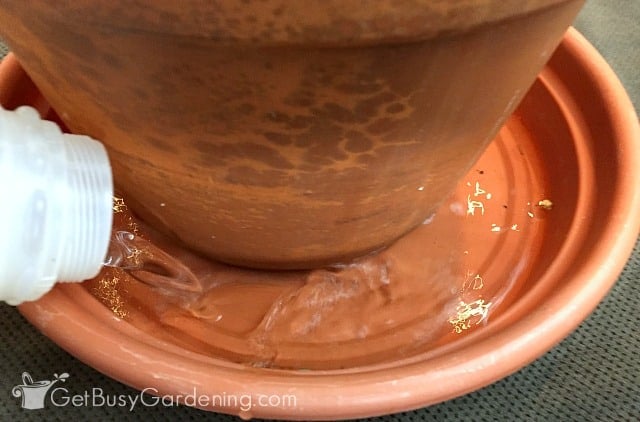
3. Use Gnat Traps
Putting a yellow sticky trap near your indoor plants is a super safe pest control method that will attract and capture the flying adults.
This only works to control the adult population, it will not take care of the problem at the source – the larvae.
But these traps will definitely prevent fungus gnats from flying around to other plants and prevent more larvae from being laid.
Try making your own DIY Fruit Fly Trap!
4. Use Organic Products
There are several organic products that you can pour over the top of the soil to help kill the gnat eggs, larvae, and pupa.
It might take a few applications to see results, and you also have to be careful not to overwater your plants in the process but they are natural. Here are a few of my favorites:
- Insecticidal soap – This will kill any bugs in the soil on contact. You could also make your own by mixing 1 teaspoon mild liquid soap with 1 liter of water.
- Neem oil – This is a natural pesticide that works to kill houseplant pests over time, and it has a residual effect to help keep them away.
- Beneficial nematodes – These are microscopic organisms that will feed on the pupa and larvae, and you can simply add them to your watering can.
- Bacillus thuringiensis israelensis (BTI) – Also known as mosquito dunks or mosquito bits, BTI is a bacteria that’s only toxic to the larvae of bugs like fungus gnats. It takes some time for it to be effective but works.
Related Post: How To Use Neem Oil As Organic Pest Control
5. Remove Gnat Infested Soil Entirely
Remove the top inch of soil and replace it with fresh, sterile, and dry potting mix. This will get rid of most of the fungus gnat eggs, larvae, and pupa, and make it easier for you to gain the upper hand.
Just keep in mind that the eggs could still hatch and mature after you remove it from your houseplant, so make sure you take the infested soil outside to the trash right away.
6. Use Soil Covers
Rather than refreshing the top inch of soil, you can add a dry layer of fine sand, gravel, or crushed granite instead. This will help deter the females from laying eggs. Plus it creates a nice decorative touch.
Or you could try a barrier top dressing, which is a non-toxic product that is specifically made for eradicating fungus gnats.
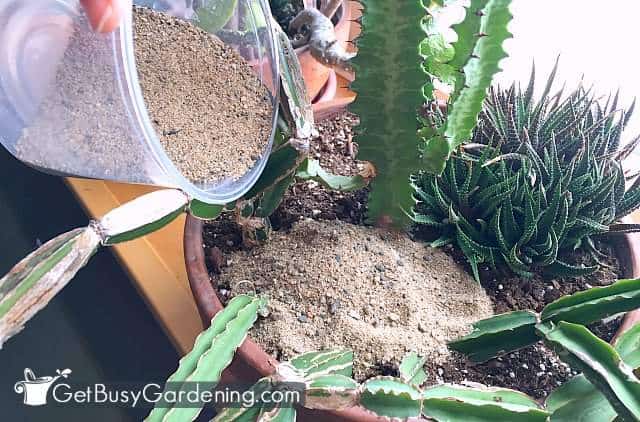
7. Store Unused Soil In A Sealed Container
Bags of potting soil can become a breeding ground for fungus gnats. So it’s important to store any of your unused mediums in sealed containers, especially if you keep them inside the house.
Fungus gnats can’t survive without oxygen, so make sure the container is airtight. I store mine in five gallon buckets with Gamma seal lids on top.
8. Never Reuse Potting Soil
I know it’s tempting to pinch pennies by reusing soil when you repot your indoor plants or after one dies, but you’re just asking for trouble.
Used soil can harbor all sorts of pests and diseases, and can quickly cause an infestation. So it’s always best to use a fresh, sterile mix, and discard the old stuff.
Related Post: 9 Homemade Insecticides & Bug Sprays For Indoor Plants
9. Use Hydrogen Peroxide as Larvacide
Treating the soil with hydrogen peroxide is a natural and effective method. Try mixing 1 part hydrogen peroxide to 4 parts water and use it to wet the top inch. Keep in mind that this will only kill the larvae and pupa, and not the adults that are flying around your plant.
Other Natural Treatments To Try
I have also heard using baking powder, vinegar, coffee grinds, tea tree oil, lavender oil, garlic, parsley, cinnamon can be effective treatments for ridding of fungus gnats.
Where Do Fungus Gnats Come From?
Though indoor plant bugs can come from anywhere, here are the 4 most common ways that fungus gnats could have gotten into your house:
- From the soil of a new pre-infested plant.
- An infested bag of potting mix.
- Other plants that were outside during the summer.
- Through the screen of open windows or doors.
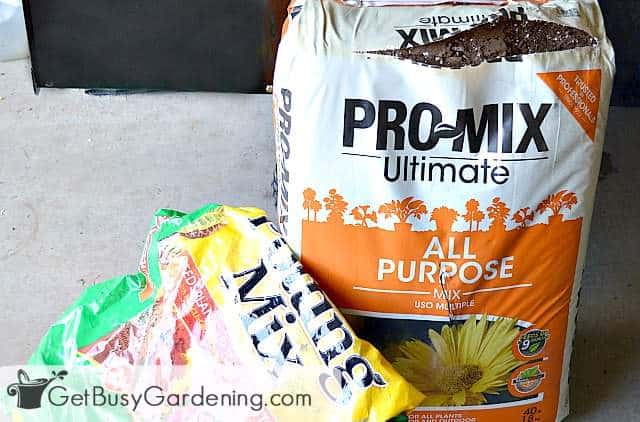
Related Post: How To Get Rid Of Houseplant Bugs Naturally
Common Questions About Fungus Gnats
While it is possible to get rid of fungus gnats, you have to be diligent with your preventative measures to keep them away permanently. The biggest problem is that they can easily come through window screens and doors. So unless you seal your home year round, it’s possible the fungus gnats will return at some point.
The short answer is no, fungus gnats will not kill your houseplants. They are usually just a nuisance and rarely destructive. Sometimes they can cause minor root damage if the infestation is heavy, but normally they only eat rotting plant material.
Everyone with indoor plants will have to fight fungus gnats at some point, it’s just a part of life. Recurring problems are difficult to prevent, and it can be very frustrating. Your best defense is to make sure you don’t overwater, properly store unused potting soil, and always maintain healthy houseplants.
If houseplant pests are driving you crazy, and you want to learn how to get rid of them once and for all, check out my Houseplant Pest Control eBook. It will help you identify common houseplant bugs, and show you exactly how to eradicate them before they kill your beloved plants. Download your copy today!
More About Houseplant Pests
- How To Debug Plants Before Bringing Them Indoors
- How To Get Rid Of Thrips On Indoor Plants
- How To Get Rid Of Spider Mites On Indoor Plants
- How To Get Rid Of Scale Insects On Houseplants
- How To Get Rid Of Whiteflies On Indoor Plants
- How To Get Rid Of Aphids On Houseplants
- How To Get Rid Of Mealybugs On Your Houseplants
Leave a comment below and share your tips for how to get rid of fungus gnats in houseplant soil.


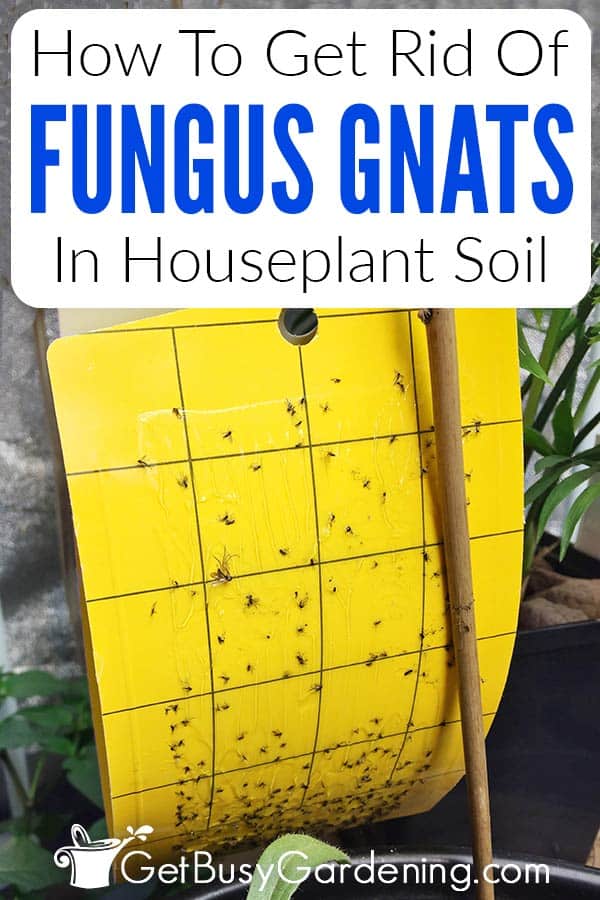

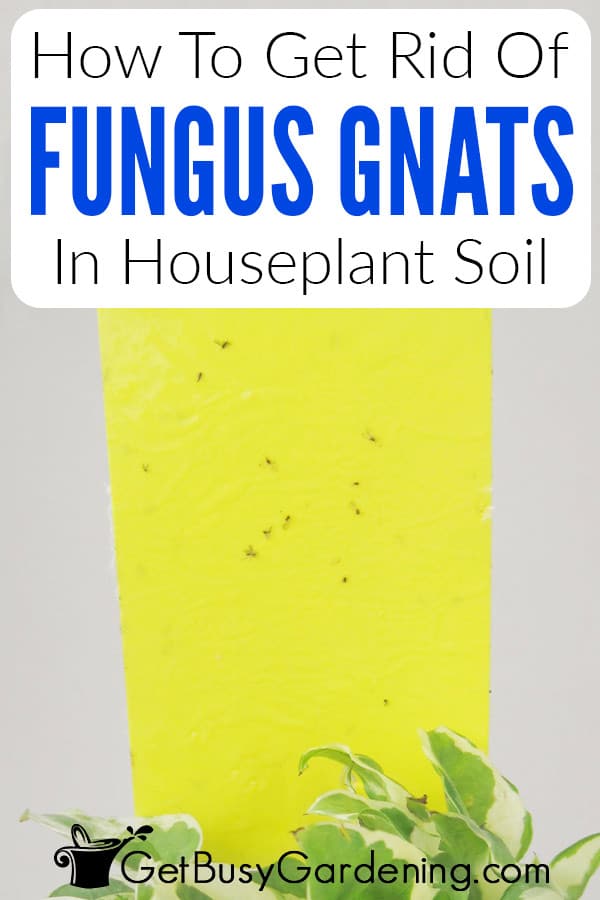
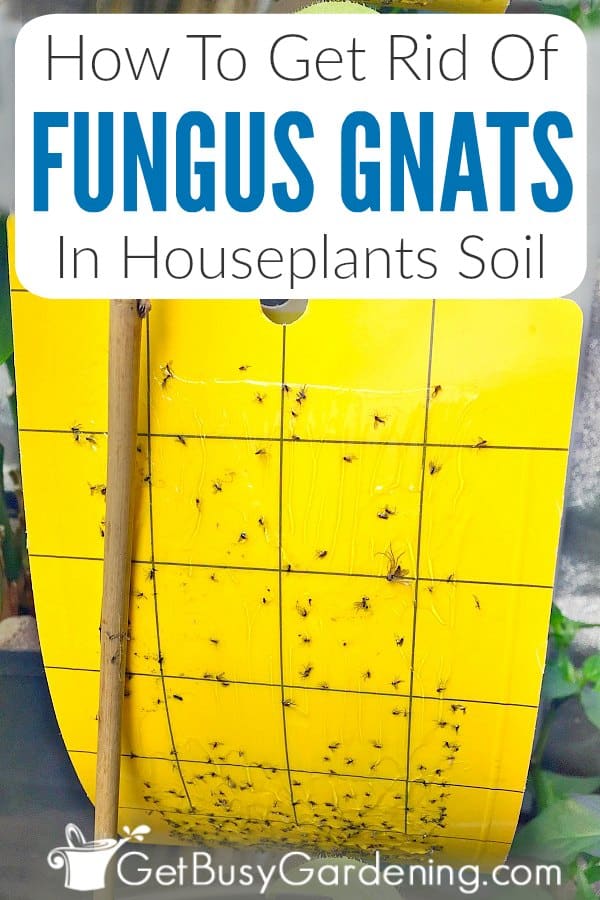
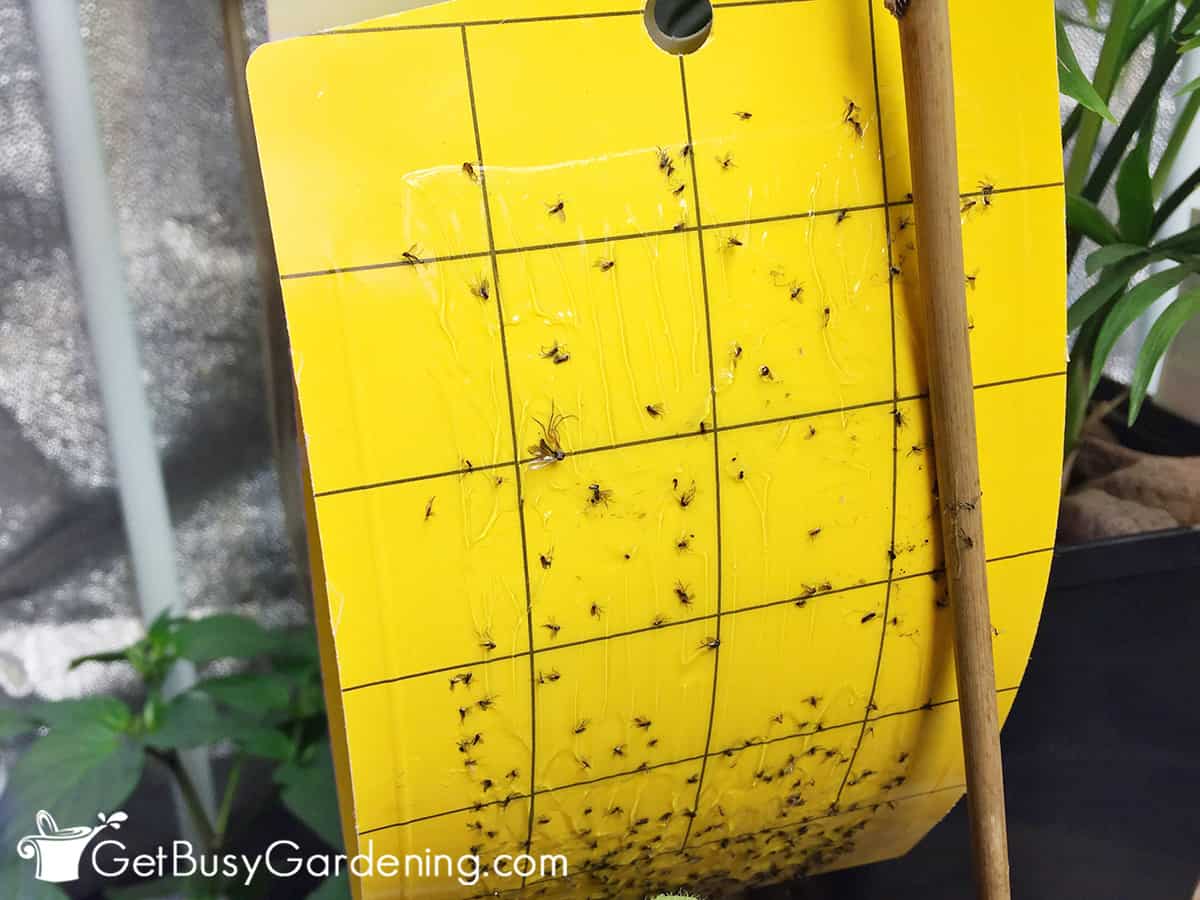


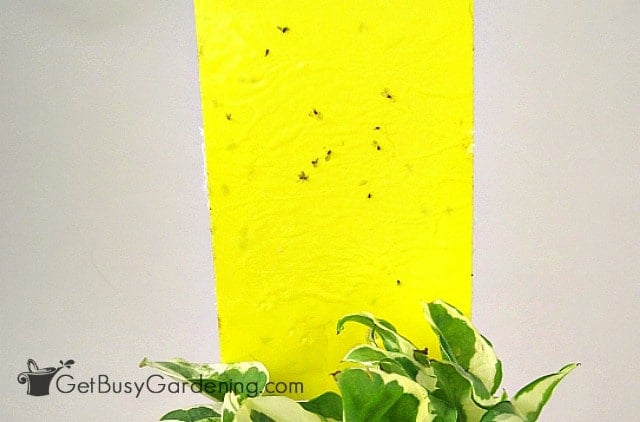
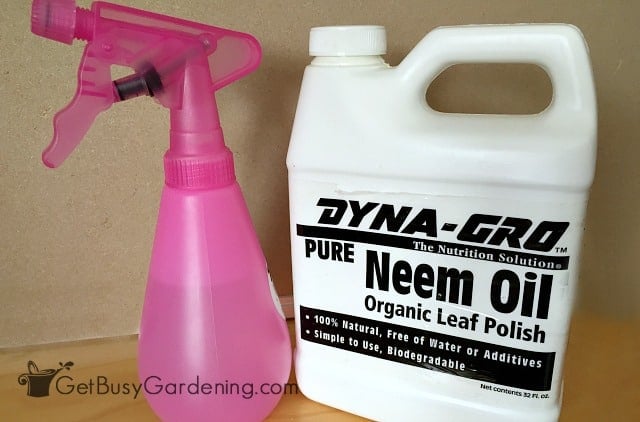
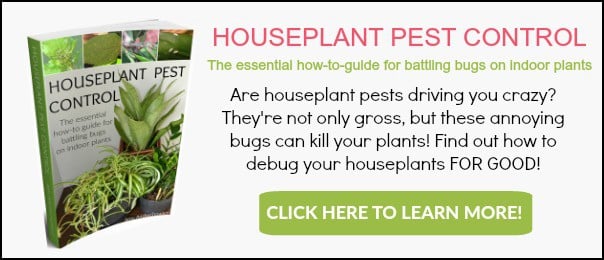

Anna says
FYI, this may be late, but Mosquito dunks or granules will also work, they are all natural. They have a particular bacteria that is feeds on the larva of both mosquitoes and Fungal gnats. I sprinkle in the fall before I bring my plants indoors for the winter and again if they start to reappear later.
Amy Andrychowicz says
Thanks for the tip about killing fungus gnat larvae! Can you share what brand of all-natural mosquito dunks you use? I definitely want to try this out.
Sally says
I looked high and low on my tablet for days to find something to annihilate those “in your face” flies and found a sure fire cure. Mix 1 part hydrogen peroxide (3%) to 4 parts water and wet the top inch of the soil. It kills the eggs instantly and all you have to do, is water one more time with the mixture as there will be some eggs laid again. I have been doing this for a few years now, and it keeps them under control. They love trying to fly up your nose, and hover around your face as they are attracted to carbon dioxide which you expel when you exhale. Hope this helps. Has no effect on the plants.
Amy Andrychowicz says
Great, thanks for your recipe! I will have to try it if fungus gnats become a problem in my house this winter after I bring all my plants back inside.
Jenny Bushey says
What about using diatomaceous earth on top instead of sand? does that work?
Amy Andrychowicz says
I would expect that DE would work to kill fungus gnats, but I haven’t tried it myself. Give it a shot, and let us know if it works for you!
shan says
it worked for me!
Amy Andrychowicz says
Woohoo, that’s great! Thanks for letting us know that the Diatomaceous earth worked to get rid of the your fungus gnats!
Pauline says
what about putting aquarium gravel instead of sand? Would that work as well?
Amy Andrychowicz says
Yes, soil covers can help to deter fungus gnats.
Viper says
The easiest method for most people will be to add a 2 or 3 inch layer of perlite on top of the soil. They hate crawling through the stuff. You can also do sand but I just don’t like the idea of too much sand mixing with my soil..
Lori says
If I leave the potting soil(still in the bag )out in the sun for a couple of days will that kill the gnats?
Amy Andrychowicz says
No, because the bags are never air tight. I would recommend finding an air tight container and putting it in there for a few weeks to kill the gnats.
Jennifer says
I have them in my closed terrarium. It has to stay moist because that’s how it works. I can’t use a layer of sand because it will kill the mosses. Because it’s a closed environment, it’s really susceptible to anything that changes it’s equilibrium so I can’t use a spray pesticide and I can’t water anything into the soil.
I have been killing them by hand as they land on the glass and I will try sticky traps. I can’t think of anything else to try – can anyone thing of something else?
Amy Andrychowicz says
I would look into getting a venus fly trap, or some other carnivorous plant to add to your terrarium.
zoe majewski says
Can I leave sand on top indefinitely? I water my Bonsai ficus let dry right out then wait a day or 2 and still as soon as I water the gnats come back within a couple days.. I did the sand it worked and over winter no gnats now spring and they are coming in again..
Amy Andrychowicz says
Yes, you can leave the sand on indefinitely, and refresh it or add more whenever you need to. Glad to hear that trick worked for you! 🙂
Bob Huston says
What would be the best remedy for pepper seedlings we started in the house ?
Amy Andrychowicz says
Water your seedlings from the bottom rather than the top, and try to allow the top of the soil to dry out a bit between waterings. I also like to run a fan near my seedlings to help keep the air moving. Also, if your seedlings are large enough, you can pot them up into new containers where it will be easier to keep the top layer of soil on the dry side. Here’s a post I wrote with all the details about how to care for seedlings that you should definitely read for more information.
Julie says
This is perfect timing for me to find, we have an infestation from one of the house plants but I can’t find which one. I’ve got it almost under control with the yellow sticky trap things but there always seems to be one or two just drifting round the house annoying us all! My husband is threatening to chuck out all the house plants which I think is a bit drastic. I’m going to try some more of these ideas. thanks so much.
Amy Andrychowicz says
The problem is that they move from plant to plant, so they’re probably in more than one of your plants. Good luck and I hope you get rid of them!
R Moran says
Peroxide mix-1 part peroxide to 4 parts water . It does work . Let soil dry first and then spray soil till well dampened. Do this every other watering.
Amy Andrychowicz says
Cool! Thanks for sharing your tip, great to know!
Alison says
I have just a very few gnats flying around. But many many house plants. If I just take away the top quarter to half inch of soil and put sand on top… Will that somehow help if there are any larvae in there?
Amy Andrychowicz says
Yes, that should help.
Phyllis Wenger says
Neem oil works great but I made the mistake of spraying it on my grape vines and haven’t gotten any grapes for 2 years now. As I understand Neem, it has an antibiotic effect which is kind of a birth control for bacteria so they die because they can’t reproduce. It seems that the Neem oil had the “birth control” effect on my grape vines. 🙁 So, I don’t use Neem oil on any of my vegetable plants anymore. Let me know if you have any other information on Neem oil!
Amy Andrychowicz says
Humm… neem oil does have fungicidal properties, but not anti-bacterial – at least not that I know of. Neem oil would not prevent grape vines from setting flowers and fruit. I suspect there’s something else going on.
Jethro says
Your grapes have some other problem not related to neem oil at all.
Danielle says
I live on an island in Cohoes NY and our house seems to be covered with little bugs all of a sudden with the nice weather starting. I had no other word to google for them in my head but gnats! We purchased the home less than a year ago, so I have no idea the source. Will talk with neighbors to see if they have the same problem. I am not sure if these tips will work as there are a lot of them everywhere, but will definitely give them a try.
Amy Andrychowicz says
Oh yuck, sorry to hear it! Good luck figuring it out!
Teresa says
I was so glad to see your article! I had soil gnats for the first time recently and had no idea what they were. I’ve had many house plants through the years, but had not experienced these little pests. This was very enlightening to me and I’ll know what to do if it happens again!
Amy Andrychowicz says
Awesome, glad I could help!
Tianna says
thanks for these tips! those gnats are always so annoying! I’m trying to have houseplants and also grow some plants outside, at the moment, so this is helpful!
Amy Andrychowicz says
Great, glad you found it helpful!